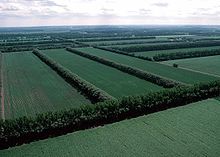Windbreak strips
A wind protection strip (also forest protection strip) is a row of trees or a forest strip up to 50 m wide that protects arable land from deflation and drying out .
Especially in the black earth areas of the Soviet Union , forest protection strips were laid out after the Russian Revolution until the end of Stalin's rule in 1953. Vasily Dokuchayev had already undertaken experiments on this before 1917 .
However, creating forest protection strips is very labor-intensive.
See also
Commons : Windbreaks - collection of images, videos and audio files
- hedge
- Columnar poplar , columnar growth with a conical crown with an average height of 25 to 30 meters
Individual evidence
- ↑ Entry in the TERRA Lexicon
- ↑ a b red-channel.de: environmental problems
- ^ Georg Jahn, Freiherr von Bissing: The economic systems of the states of Eastern Europe and the People's Republic of China . Duncker & Humblot, 1962 ( Google Books ).
- ↑ "The steppe forest planting and the planting of the seedlings by hand is a laborious process compared to the sowing of tree and bush species and requires 12 to 16 days' work per hectare" In: W. Galjuschew, S. Jelin, G. Netschetow, S Urinowa, G. Schestow: Mechanization of sowing, planting and the care of forest belts . In: Deutsche Agrartechnik . tape 2 , no. 4 , 1952, pp. 115-120 ( PDF ).

